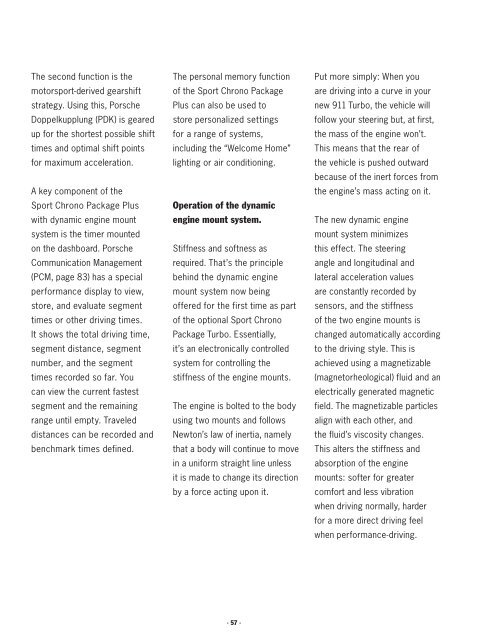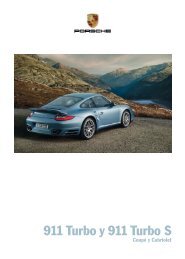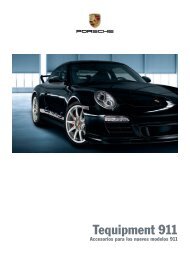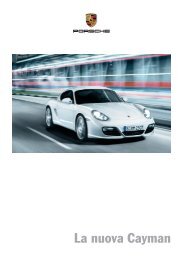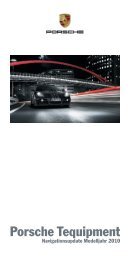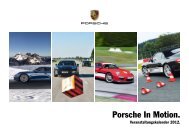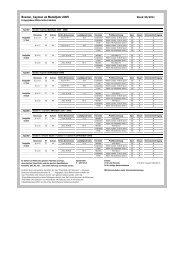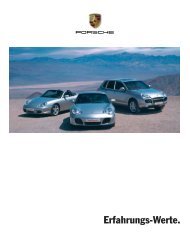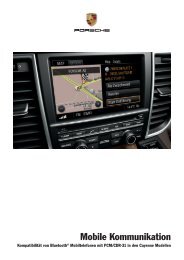The 911 Turbo and 911 Turbo S
The 911 Turbo and 911 Turbo S
The 911 Turbo and 911 Turbo S
Create successful ePaper yourself
Turn your PDF publications into a flip-book with our unique Google optimized e-Paper software.
<strong>The</strong> second function is the<br />
motorsport-derived gearshift<br />
strategy. Using this, Porsche<br />
Doppel kupplung (PDK) is geared<br />
up for the shortest possible shift<br />
times <strong>and</strong> optimal shift points<br />
for maximum acceleration.<br />
A key component of the<br />
Sport Chrono Package Plus<br />
with dynamic engine mount<br />
system is the timer mounted<br />
on the dashboard. Porsche<br />
Communication Management<br />
(PCM, page 83) has a special<br />
performance display to view,<br />
store, <strong>and</strong> evaluate segment<br />
times or other driving times.<br />
It shows the total driving time,<br />
segment distance, segment<br />
number, <strong>and</strong> the segment<br />
times recorded so far. You<br />
can view the current fastest<br />
segment <strong>and</strong> the remaining<br />
range until empty. Traveled<br />
distances can be recorded <strong>and</strong><br />
benchmark times defined.<br />
<strong>The</strong> personal memory function<br />
of the Sport Chrono Package<br />
Plus can also be used to<br />
store personalized settings<br />
for a range of systems,<br />
including the “Welcome Home”<br />
lighting or air conditioning.<br />
Operation of the dynamic<br />
engine mount system.<br />
Stiffness <strong>and</strong> softness as<br />
required. That’s the principle<br />
behind the dynamic engine<br />
mount system now being<br />
offered for the first time as part<br />
of the optional Sport Chrono<br />
Package <strong>Turbo</strong>. Essentially,<br />
it’s an electronically controlled<br />
system for controlling the<br />
stiffness of the engine mounts.<br />
<strong>The</strong> engine is bolted to the body<br />
using two mounts <strong>and</strong> follows<br />
Newton’s law of inertia, namely<br />
that a body will continue to move<br />
in a uniform straight line unless<br />
it is made to change its direction<br />
by a force acting upon it.<br />
· 57 ·<br />
Put more simply: When you<br />
are driving into a curve in your<br />
new <strong>911</strong> <strong>Turbo</strong>, the vehicle will<br />
follow your steering but, at first,<br />
the mass of the engine won’t.<br />
This means that the rear of<br />
the vehicle is pushed outward<br />
because of the inert forces from<br />
the engine’s mass acting on it.<br />
<strong>The</strong> new dynamic engine<br />
mount system minimizes<br />
this effect. <strong>The</strong> steering<br />
angle <strong>and</strong> longitudinal <strong>and</strong><br />
lateral acceleration values<br />
are constantly recorded by<br />
sensors, <strong>and</strong> the stiffness<br />
of the two engine mounts is<br />
changed automatically according<br />
to the driving style. This is<br />
achieved using a magnetizable<br />
(magnetorheological) fluid <strong>and</strong> an<br />
electrically generated magnetic<br />
field. <strong>The</strong> magnetizable particles<br />
align with each other, <strong>and</strong><br />
the fluid’s viscosity changes.<br />
This alters the stiffness <strong>and</strong><br />
absorption of the engine<br />
mounts: softer for greater<br />
comfort <strong>and</strong> less vibration<br />
when driving normally, harder<br />
for a more direct driving feel<br />
when performance-driving.


